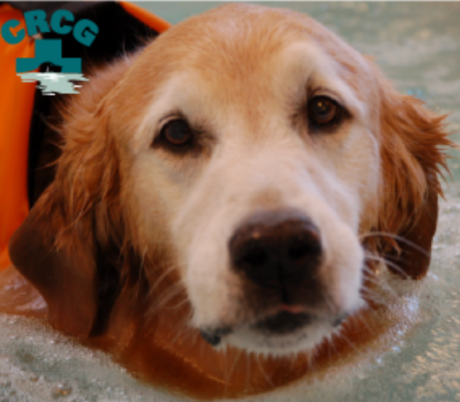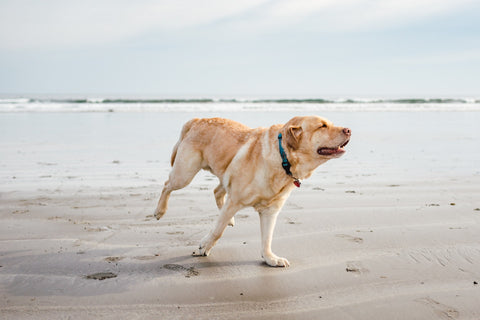

MANAGING OSTEOARTHRITIS
Osteoarthritis is common amongst both dogs and people—it’s one of the things about which we can commiserate with our furry companions. Put simply, “osteoarthritis” means “bony joint inflammation.” That’s an oversimplified representation of a complex degenerative process, but that’s the basic idea. Just like in people, arthritis is the result of bony changes within joints; once the cartilaginous “brake pads” have worn down, bone grinds on bone, resulting in microtrauma, inflammation, and pain. This, then, often leads to decreased use of limbs, muscle wasting, and immobility.
Perhaps because we can relate to the woes of arthritis, it is a common thing for vets to address at any given appointment. Unfortunately, there is no cure for it, nor one “silver bullet” treatment. Many factors play into this condition, and as such it requires a multifactorial treatment plan. If improperly managed, arthritis can lead to premature euthanasia due to extreme discomfort. Here are the basics for managing arthritis in your dog to help ensure a long, happy life.
HEALTHY WEIGHT. The most important factor in managing arthritis is weight management. That’s significant enough to say again, so let me repeat it: The most important factor in managing arthritis is weight management. More weight means more stress on arthritic joints. No other factor is as important in keeping your pet comfortable. Even with a slue of other aids, such as medications, supplements, even surgery, your pet will still be in pain if he or she is carrying extra pounds. One study showed that in arthritic dogs, healthy weight management increased the median life span by two years! In other words, dogs of a healthy weight were comfortable enough to delay euthanasia by an average of two years relative to their overweight cohorts.
It can be difficult to help your dog stay slim if he or she is already arthritic and slowing down. Do not give your dog “free choice” food, but feed him or her in measured meals two or three times a day. Use a measuring cup so you know exactly how much you’re feeding rather than guessing. If you’re already doing that, try replacing a quarter to half of a meal with green beans (fresh, frozen, or no-sodium canned), or feeding a favorite vegetable or fruit for treats instead of high-calorie processed ones at the store. If your dog has specific dietary limitations, talk to your vet about some options you might try.
CONSISTENT EXERCISE. In addition to helping shed pounds and keep them off, this is an important piece of osteoarthritis management. A moving joint is a healthy joint. If your dog never gets exercise, joints don’t move, weight builds up, and muscles waste away. If you and your dog are “weekend warriors,” and squeeze ALL your exercise into a couple days a week, that aggravates arthritis and causes more inflammation. The same thing happens with “spring fling” dogs that have been lazy all winter and hit the trails running in the springtime.
Instead, focus on small doses of daily exercise. Work within your dog’s physical abilities; if your dog can only make it around the block, then that is his or her limit. If he or she can play fetch for half an hour, make it a priority to spend that time with your dog. It is essential to helping your dog maintain his or her mobility.
REHAB. If you are having difficulties keeping your dog’s weight down or his activity level up, we can help with rehab. The underwater treadmill is an excellent tool to help reduce stress on painful joints while strengthening muscles to help maintain mobility. Modalities such as laser and ultrasound can relieve chronic pain, reducing the need for medications. Massage, acupuncture, chiropractic work, and joint range of motion are other tools that rehab has to offer. Even simply swimming for 10-15 minutes can loosen up tense muscles and provide excellent cardiovascular exercise. The exact exercises and modalities used in your dog’s treatment will be up to your rehab vet, but together, you can make a significant difference in keeping Fido healthy!
NON-STEROIDAL ANTI-INFLAMMATORIES (NSAID’s). Most clients are familiar with the dog-equivalent of ibuprofen, carprofen or Rimadyl. (Please note: never give a dog any human NSAID’s or acetaminophen, as they can quickly cause liver failure and death. Dog livers are different from human livers and cannot handle drugs made for people.) Anti-inflammatories alleviate pain whenever there is inflammation present in an arthritic joint, but they all come with adverse effects. Unfortunately, many veterinarians build a treatment plan centered around NSAID’s. They should be used sparingly due to side-effects; consider these a bonus of modern medicine to have during times of increased pain (due to cold weather, increased activity, or a slip or fall, for example) rather than a cornerstone of treatment.
SUPPLEMENTS. Arthritis supplements can be very useful, but I caution all my clients to do their own research first before purchasing any. By nature, supplements and other homeopathic remedies are not regulated by the Federal Drug Administration (FDA), so there is no one to ensure that the label matches the contents. For example, one study evaluated label claims for chondroitin sulfate; of 32 products tested, only 5 contained the actual ingredients and concentrations of chondroitin sulfate advertised on the label. There is a lack of scientific studies when it comes to supplements, as well, so it can be a tricky subject to approach. Having said that, innumerable people have seen a difference in their dog with several reputable supplements, and if used in conjunction with weight management and an active lifestyle, they can be very beneficial.
Glucosamine, chondroitin sulfate, and omega-3 fatty acids have been shown to be the most beneficial supplements available. They contain essential factors for maintaining healthy cartilage within joints, slowing the breakdown that occurs with normal wear and tear.
OTHER THERAPIES. Less commonly pursued and treatments include intra-articular injections (injecting a drug directly into the joint) and surgeries. Sticker shock usually accompanies these therapy options, but they can be useful if the other therapies used above are not adequate to keep your dog comfortable. Injections contain purified versions of important cartilage and joint components, such as hyaluronic acid and glycosaminoglycans. Surgeries can realign a joint, replace a joint, or eliminate bony chunks that have broken free and are floating within the joint. These options should be discussed carefully with your veterinarian before undertaking them due to their potential risks, especially in older animals.
For more information on managing your dog’s arthritis, or if you have questions not addressed in this article, please contact us at CRCG or your regular veterinarian. We are happy to help, and we look forward to being part of the team to keep your fluffy friend comfortable and going strong for as long as possible!
Author: Lori Beuerle


